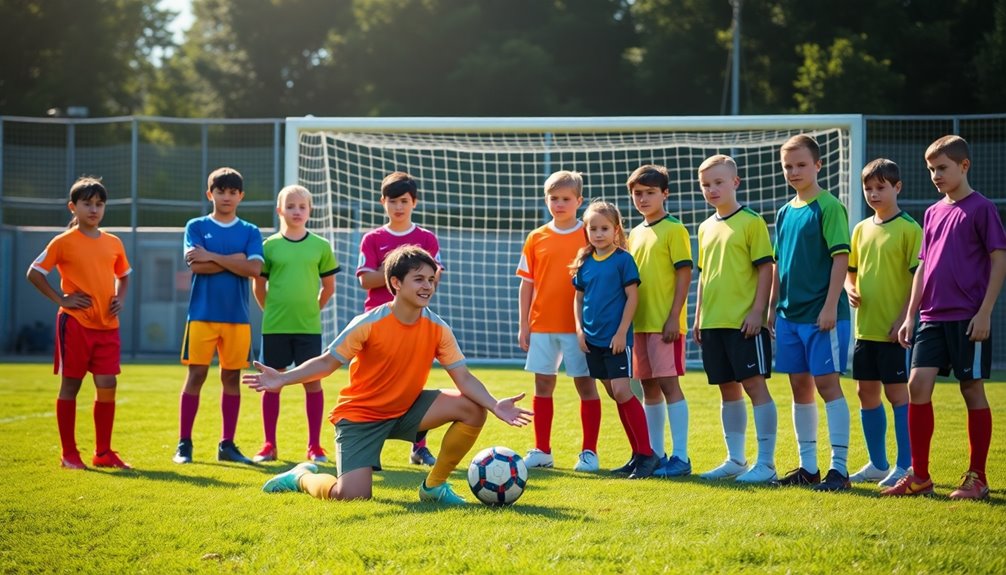
Youth Soccer Positions Explained for New Players
February 19, 2025In youth soccer, there are four main positions: Goalkeeper, Defender, Midfielder, and Forward. As a new player, each role has unique responsibilities. The goalkeeper protects the goal, defenders prevent scoring, midfielders control the game, and forwards aim to score. Communication is key for teamwork and success. Depending on the age group and team size, you'll have opportunities to explore different positions. Understanding your role can enhance your performance and enjoyment. By familiarizing yourself with these positions, you'll be better prepared for the game ahead and ready to elevate your skills further.
Overview of Youth Soccer Positions
In youth soccer, understanding the various positions is fundamental for player development and teamwork. Players typically fill four main roles: Goalkeeper, Defender, Midfielder, and Forward. Each position has its own responsibilities and skill sets, contributing to the overall function of the team. Effective communication among players is essential in ensuring that each position functions optimally during games.
As younger players often simplify positions into offense and defense, they can focus on fundamental skills before specializing. For instance, defenders are tasked with stopping the opposing team from scoring, while forwards aim to score goals. Midfielders serve as a link between defense and offense, controlling the game's pace and distribution. The role of a defending midfielder is crucial, as it helps break up opponent attacks and maintain possession for counterattacks. Additionally, effective teamwork is essential for ensuring that all players work cohesively to achieve their goals.
Youth soccer teams, especially at the U10 level with 7 v 7 formats, allow players to explore diverse positional play. This flexibility is essential, as it encourages you to try different roles, helping you develop a broader understanding of the game. The experience gained from role-specific training can significantly enhance a player's ability to adapt to various positions on the field.
Importance of Team Roles
Understanding the importance of team roles in youth soccer is essential for both individual development and overall success on the field. Each player has specific responsibilities linked to their position, whether as a goalkeeper, defender, midfielder, or forward. Recognizing these roles helps you identify where you can best utilize your strengths and contribute to the team's objectives. Furthermore, effective communication among players is crucial for coordinating defensive strategies and attacking plays.
Teamwork and communication are imperative in executing these roles effectively. By understanding the different positions and their unique traits, you'll enhance coordination with your teammates during matches. This familiarity encourages open dialogue, allowing players to adjust strategies on the fly. Moreover, experiencing various roles deepens your understanding of the game. This well-rounded perspective is essential for your growth and adaptability in future competitive environments. When players grasp the importance of team roles, it fosters accountability and encourages everyone to work together as a cohesive unit. Additionally, knowing the specific roles and responsibilities of each position will help you appreciate how every player contributes to the team's strategy.
Ultimately, embracing these responsibilities leads to improved performance and increases the enjoyment of the game for all participants. Proper placement within these roles helps maximize team strengths and minimize weaknesses. By appreciating the significance of each position, you'll develop not only as an individual player but also as a key contributor to your team's success.
Understanding Player Positioning
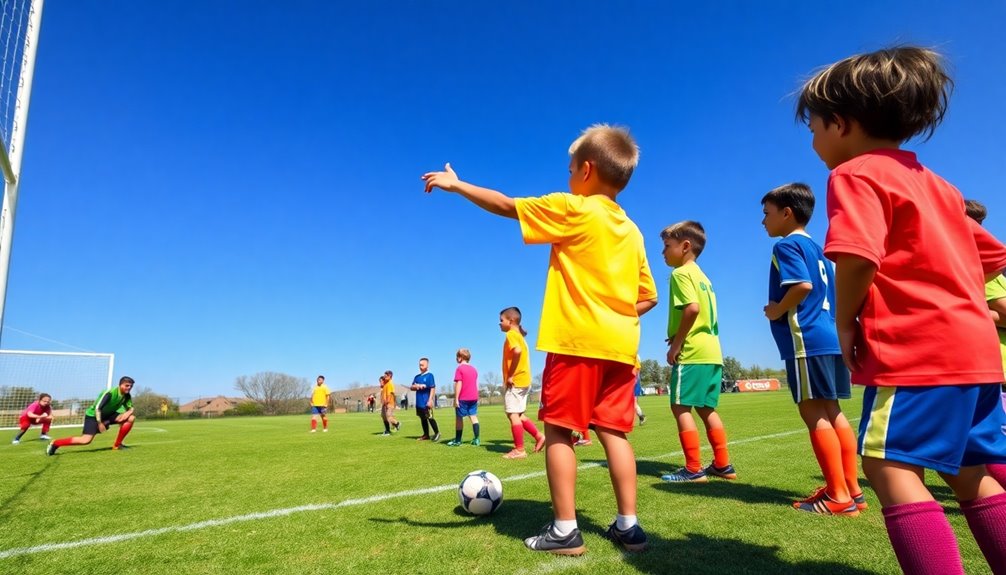
Understanding player positioning is key to your team's success on the field. It helps with effective spacing and guarantees that everyone knows their role, whether you're attacking or defending. Additionally, tactical flexibility allows teams to adapt their formations based on the strengths and weaknesses of both their players and opponents. A well-defined understanding of formation selection can significantly enhance both defensive and offensive strategies during a match. Effective team coordination can further improve your overall defensive organization and performance.
Importance of Position Roles
Player positioning in youth soccer isn't just a matter of where you stand on the field; it's the key to effective teamwork and individual performance. Understanding the responsibilities of each position allows you to contribute more considerably to your team.
For instance, midfielders need to control the center field to create chances and support both the defense and the attack. By grasping your role within different soccer formations, you can enhance communication and execution during matches.
Here are a few reasons why position roles matter:
- Teamwork: Knowing your position helps you work better with teammates, ensuring everyone knows their responsibilities.
- Skill Development: Exploring various roles allows you to identify your strengths, which can improve your overall game.
- Tactical Awareness: Understanding player positioning prepares you for more competitive environments, fostering strategic thinking on the field.
When you focus on your position and its importance, you'll not only boost your performance but also contribute to your team's success. Embrace your role, and watch how it transforms your gameplay!
Effective Player Spacing
Maintaining effective player spacing is essential for creating a well-structured team that can execute successful plays during a match. When you focus on your positioning relative to your teammates, especially the midfielders, you help control the center field. This control not only increases your chances of winning possession but also creates crucial passing lanes for ball movement.
In youth soccer, formations like 2-3-1 or 3-3-1 highlight the significance of spacing. These formations allow midfielders to shift smoothly between attacking and defensive roles, making it easier for the team to adapt to the flow of the game.
You should always be aware of your distance from both teammates and opponents; overcrowding can stifle your team's effectiveness and lead to missed opportunities.
Coaches often use visual diagrams to demonstrate proper spacing, ensuring that players grasp their roles within the overall team formation and strategy. By maintaining effective player spacing, you contribute to a more dynamic game, allowing for quicker plays and better coordination on the field.
Goalkeeper Responsibilities
As a goalkeeper, you need specific traits like mental resilience and quick reflexes to handle the pressure of the game. Mastering essential techniques for shot-stopping and communication with your defense can make all the difference in keeping the opposing team from scoring. Additionally, your ability to maximize your field presence can significantly enhance your effectiveness in directing your teammates. Your role is pivotal, so understanding these responsibilities is key to your success on the field. Additionally, being aware of goalkeeper box rules can help you make better decisions during matches. Moreover, having a strong grasp of defensive strategies will enable you to anticipate plays and coordinate better with your team.
Key Traits Required
The role of a goalkeeper is unique and demanding, requiring a blend of specific traits to excel. As the only player allowed to use their hands within the penalty area, you're responsible for preventing the ball from entering the goal. Here are some key traits that will help you succeed:
- Agility: Quick lateral movements are essential for diving to save shots.
- Communication: You need to organize your defense, ensuring teammates are positioned correctly during set plays and open play.
- Mental Resilience: Facing criticism for goals conceded is part of the job, so maintaining focus and confidence is essential.
Strong ball-handling skills are important too, as you'll need to catch, block, and distribute the ball effectively to initiate counter-attacks.
A commanding presence helps instill confidence in your defense, making them feel secure as they defend. You'll need bravery to confront attackers and tackle the challenges that come your way.
Balancing all these traits won't only enhance your performance but also positively impact your team's overall dynamic. Embrace your role as a goalkeeper, and develop these fundamental traits to become a reliable last line of defense!
Essential Game Techniques
Understanding the key traits of a goalkeeper sets the foundation for mastering the techniques that define your role on the field. As a goalkeeper, you must excel in shot-stopping, organizing the defense, and communicating effectively with your teammates, including the defensive midfielder and central midfielders. Your unique ability to use your hands within the penalty area is essential for preventing goals.
To perform your duties effectively, focus on proper positioning and agility. You need to be brave, ready to dive for the ball while maintaining mental resilience to bounce back from mistakes. When a shot comes your way, your primary goal is to block it. If the ball is loose, you must retrieve the ball quickly to regain control.
Additionally, when the opportunity arises, clear the ball with precision to initiate counter-attacks. Your throws should be accurate, enabling your teammates to play effectively.
Defensive Player Roles

Defensive players are essential to a soccer team's success, playing key roles in both protecting the goal and supporting the attack. As a defensive player, you'll have specific responsibilities depending on your position.
- Center Defenders (Center Backs) organize the defense, intercept crosses, and provide a strong physical presence. They must also maintain a strong defensive stance to enhance their agility in challenging attackers. Additionally, practicing transition and recovery drills helps center defenders quickly regain their shape after possession changes.
- Right and Left Defenders (Fullbacks) excel in one-on-one situations, tracking fast dribblers while also contributing to the attack when you have the ball.
- Sweepers act as the last line of defense, clearing balls that bypass the center-backs.
Effective communication and coordination among defensive players are vital for maintaining team structure, especially during set pieces or counterattacks. You need to be vocal and alert, ensuring everyone knows their roles.
Moreover, defensive players must exhibit strong tackling skills and resilience in duels. You'll also need to shift quickly between defensive and offensive roles, especially in formations like 4-4-2 or 3-3-1. Additionally, your ability to anticipate opponents' movements can greatly enhance your overall defensive effectiveness.
Midfield Dynamics
In the heart of the game, midfielders bridge the gap between defense and attack, making their roles essential for team success. You'll encounter three main types of midfielders: defensive midfielders, central midfielders, and attacking midfielders. Each has unique responsibilities that contribute to the team's overall performance.
Defensive midfielders sit in front of the defense, focusing on regaining possession and disrupting opponent attacks. They use their physicality and tactical awareness to support the backline, ensuring team structure.
Central midfielders act as playmakers, moving into space to create scoring opportunities while also managing defensive duties. Their versatility is vital for maintaining the team's flow.
Attacking midfielders support forwards in offensive plays, requiring excellent passing abilities and a keen sense of positioning. A well-rounded midfielder possesses a high soccer IQ, allowing for effective decision-making even under pressure.
You'll need strong dribbling and passing skills to initiate plays and connect with teammates. By mastering these dynamics, you'll enhance your contribution to the game and help your team achieve its goals.
Embrace your role in the midfield, and you'll find yourself at the center of the action!
Forward Positioning
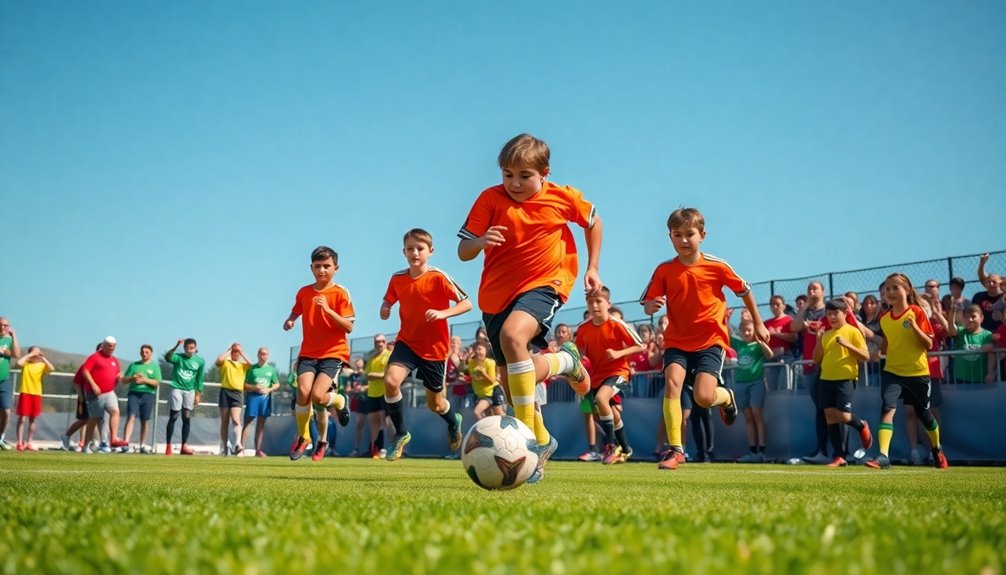
As a forward, your main goal is to create and convert scoring opportunities right in front of the opponent's net.
You'll need to understand the distinct roles of a center forward and a winger, each requiring unique positioning strategies to maximize your team's offensive potential.
Mastering goal-scoring techniques will also be essential as you work to outsmart defenders and find the back of the net.
Center Forward Responsibilities
The center forward plays an essential role in a team's offensive strategy, positioned closest to the opponent's goal and tasked with being the primary goal scorer. You'll need exceptional finishing skills and composure under pressure to convert chances into goals effectively.
Your mobility and agility are vital for creating space and receiving passes, allowing you to attack the goal with confidence.
As a center forward, you'll be responsible for leading the attack and maintaining offensive pressure. This often involves working closely with wingers and midfielders to facilitate goal-scoring opportunities.
Here are some key responsibilities to keep in mind:
- Create opportunities: Use your movement to draw defenders and open up space for teammates.
- Communicate effectively: Lead your team by motivating players and coordinating attacks.
- Hold off defenders: Utilize your strength and speed to maintain possession in the attacking third.
Winger Positioning Strategies
Positioned on the flanks, wingers play an essential role in stretching the opponent's defense and creating space for central players. Your primary focus should be on effective winger positioning, which involves finding pockets of space between defenders. Use your strong dribbling skills and pace to beat defenders in one-on-one situations. When you receive the ball, look to deliver precise crosses that your forwards can convert into goals.
Remember, you're not just an attacker; you'll need to shift quickly between offensive and defensive roles. When your team is defending, support your fullbacks by tracking back and helping to close down the flanks.
During offensive plays, communicate with center forwards and midfielders to coordinate overlapping runs. This communication is essential for creating scoring opportunities and ensuring your movements are synchronized.
Make diagonal runs to receive through balls and always keep an eye out for where you can find space. By mastering these positioning strategies, you'll become a significant asset to your team, enabling both your teammates and yourself to shine on the field.
Goal Scoring Techniques
Scoring goals is the ultimate objective for forwards, and mastering effective positioning is key to achieving that goal. As a forward, your primary focus should be on creating and capitalizing on goal-scoring chances. Whether you're a center forward, winger, or attacking midfielder, your positioning can make all the difference.
- Stay Alert: Always anticipate where the ball will go to seize scoring opportunities.
- Communicate: Coordinate with your teammates to maximize openings and passing options.
- Be Mobile: Use your quickness to evade defenders and find space in the box.
Center forwards should position themselves close to the opponent's goal, ready to take advantage of rebounds or misplays. Wingers need to maintain width, using their speed and dribbling to deliver accurate crosses for center forwards to finish.
Attacking midfielders play a crucial role by making decisive runs and creating goal-scoring chances through skillful passing. Effective communication with your teammates is imperative; it helps you coordinate runs and guarantees everyone's on the same page.
Youth Soccer Formations
Youth soccer formations play an essential role in shaping how your team attacks and defends during a match. Understanding these formations helps you utilize your players effectively, whether they're defenders, midfielders, or forwards.
For instance, in 6v6 games, the common 2-2-1 formation positions two defenders and two midfielders to support a single forward, balancing both attacking and defensive roles.
When playing 7v7, the 2-3-1 formation emphasizes midfield support, allowing three midfielders to control the game. If you're in an 8v8 match, consider the 3-3-1 formation, which provides strong defensive support while encouraging midfielders to shift smoothly between attacking and defending.
Choosing the right youth soccer formations can greatly enhance your team performance. Tailor formations to your players' skill levels; compact structures often benefit younger, less experienced players by simplifying their positions and responsibilities.
Coaching Techniques
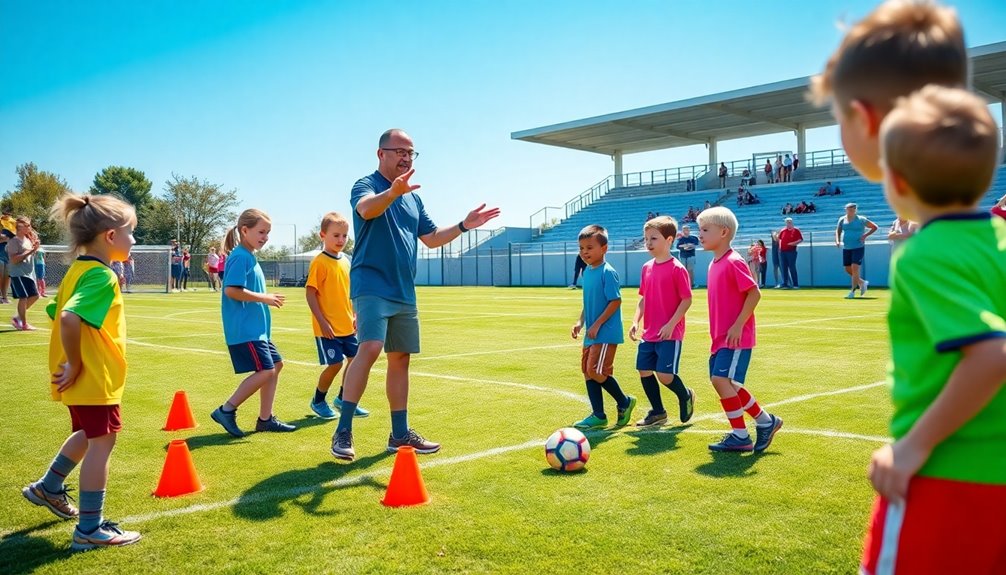
Effective coaching techniques are essential for helping players understand their roles and responsibilities on the soccer field. Coaches should emphasize the importance of positional understanding, as this fosters teamwork and enhances overall game comprehension.
Tailored warm-up sessions can build confidence and prepare players mentally and physically for their roles during the game.
Here are some key coaching techniques to reflect upon:
- Encourage individual strengths: Help players practice their individual strengths, which can contribute greatly to the team's success.
- Provide constructive feedback: Offering constructive feedback on positional play reinforces learning and promotes positive development among young players.
- Utilize training tools: Using tools like the OPEN GOAAAL® Soccer 3-in-1 Trainer can enhance practice efficiency, allowing players to focus on their positional responsibilities while increasing playing time and reducing distractions.
Player Development Strategies
In any soccer setting, player development strategies play an essential role in shaping young athletes into well-rounded competitors. By encouraging players to experience multiple positions in youth soccer, you help them discover their strengths and preferences. This exploration fosters a versatile skill set that's imperative for their growth.
You can implement tailored warm-up sessions focused on specific positional skills, like dribbling for forwards or passing for midfielders. This targeted approach enhances individual player development.
Using small-sided games is another effective strategy; they increase player engagement and allow for more touches on the ball, promoting teamwork and spatial awareness.
Constructive feedback during practice is critical. By emphasizing each player's contributions to the team's success, you build their confidence.
Incorporate exercises that enhance tactical awareness, such as positional drills simulating game scenarios, to improve decision-making and understanding of the game's flow.
Ultimately, these player development strategies not only elevate individual players but also strengthen the overall team, leading to a more competitive and cohesive unit on the field.
Team Sizes and Substitutions
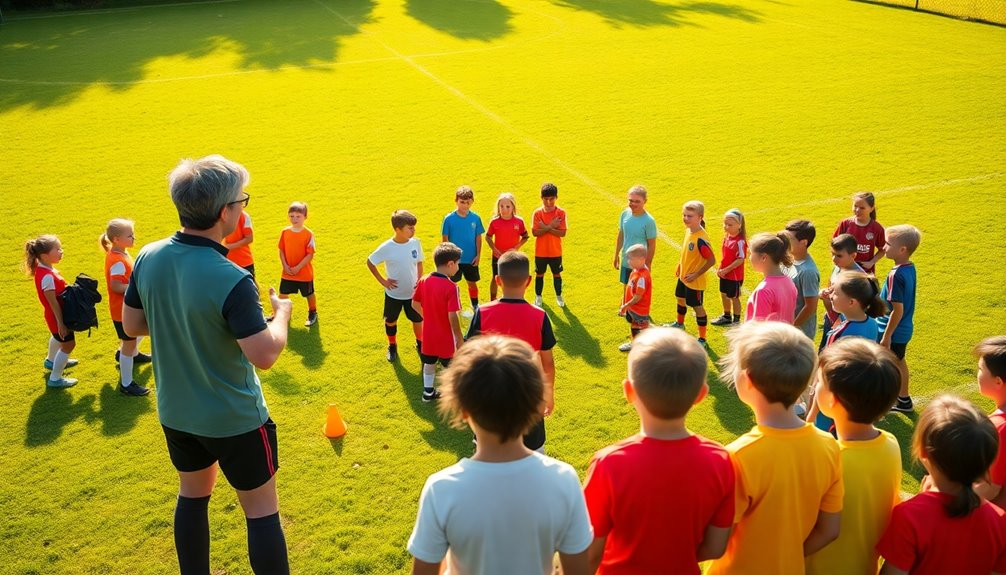
Balance in team sizes and substitutions plays an essential role in youth soccer, impacting player development and overall team performance. Different age groups have varying team sizes, which influence how you engage with the game. For instance, U5 teams have just 3 players (3 v 3), while U16+ teams can have up to 11 players (11 v 11).
To enhance your experience, consider these points about substitutions:
- Energy Management: Substitutions keep players energized, allowing everyone to contribute effectively.
- Position Exploration: With the right team sizes, you can try out different positions, enhancing your skills.
- Effective Rotation: An ideal team size, like 10-12 players for 7 v 7 matches, facilitates effective rotation, giving everyone a chance to shine.
For 9 v 9 games, a team size of 12-13 players works well, ensuring coverage and the chance to experience various roles.
In 11 v 11 matches, aim for 15-18 players to keep the competition lively and engaging.
Essential Soccer Gear
When you step onto the field, having the right soccer gear can make all the difference in your performance and enjoyment of the game.
Start with a good pair of cleats, specially designed for traction on different playing surfaces. They'll help you maintain stability and speed, vital for every position.
Don't forget your soccer socks; they provide comfort and protection while holding your shin guards securely in place to prevent injuries.
A quality soccer ball is essential too. For younger players, a size 3 ball is ideal, while size 4 suits players aged U9-U12. Practicing with the right ball enhances skill development and gameplay.
If you're a goalkeeper, invest in specialized goalkeeper gloves. These gloves give you the grip you need and protect your hands during dives and stops.
Lastly, check out the latest soccer apparel available at SOCCER.COM. Having the right outfit not only boosts your confidence but also guarantees you're comfortable during matches and practices.
With the right soccer gear, you're set to enjoy the game and perform at your best!
Practicing With Training Aids
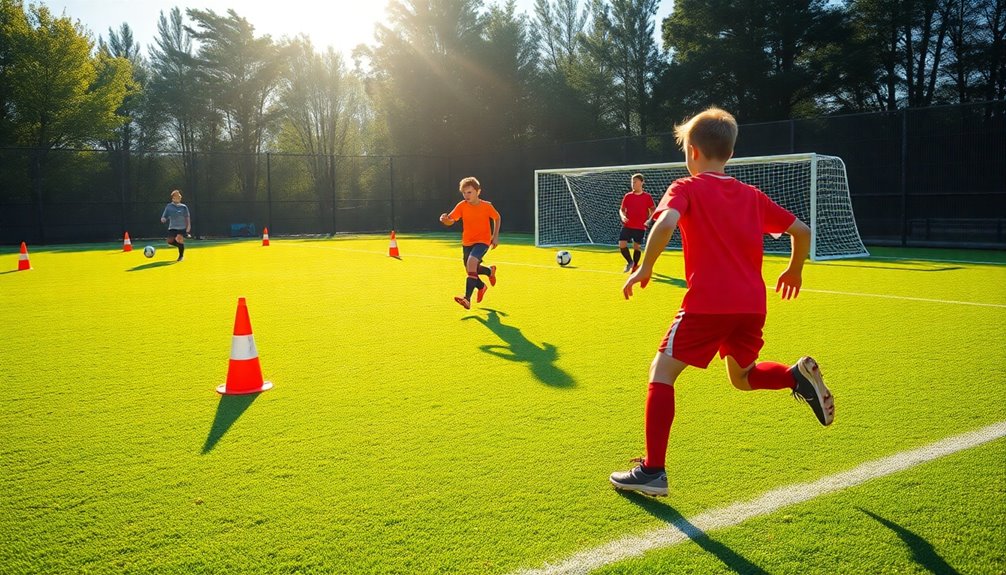
Effective practice is essential for young soccer players, and using training aids can greatly enhance your training sessions. By incorporating tools like the OPEN GOAAAL® Soccer 3-in-1 Trainer, you can boost your practice efficiency. This multifunctional aid combines a goal, rebounder, and backstop, allowing for uninterrupted play.
Training aids help you develop specific skills tailored to your position, improving your shooting accuracy, passing precision, and defensive techniques. Visual aids, such as diagrams and cones, clarify your positional roles and spacing on the field, which leads to better gameplay execution.
Here are some benefits of practicing with training aids:
- Enhanced skill development: Focus on targeted drills to refine your abilities.
- Boosted teamwork: Drills that involve multiple players promote communication and collaboration.
- Increased confidence: Repeated practice in scoring scenarios can empower players, especially in attacking positions.
Consistent use of training aids not only enhances individual skills but also fosters a cohesive playing style among teammates.
Embracing these tools won't only make practice more engaging but will also prepare you for success on the field.
Conclusion
In youth soccer, understanding positions is like piecing together a puzzle—each role fits perfectly to create a cohesive team. Embrace your position and learn how it contributes to the game, whether you're defending, attacking, or guarding the goal. Remember, every player plays a crucial role, and with practice and teamwork, you'll grow not just as an athlete but as a teammate. So lace up your cleats, hit the field, and enjoy the beautiful game together!


